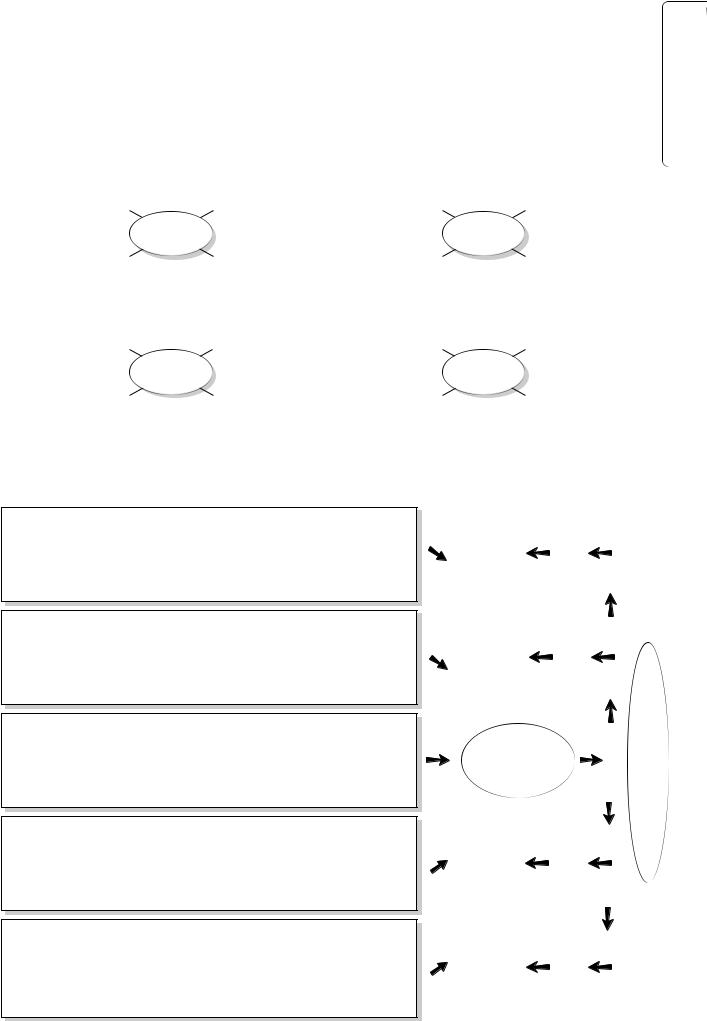
Frameworks
.pdf
Business English
Frameworks
Paul Emmerson
PUBLISHED BY THE PRESS SYNDICATE OF THE UNIVERSITY OF CAMBRIDGE
The Pitt Building, Trumpington Street, Cambridge, United Kingdom
CAMBRIDGE UNIVERSITY PRESS
The Edinburgh Building, Cambridge CB2 2RU, UK 40 West 20th Street, New York, NY 10011–4211, USA
477 Williamstown Road, Port Melbourne, VIC 3207, Australia Ruiz de Alarcón 13, 28014 Madrid, Spain
Dock House, The Waterfront, Cape Town 8001, South Africa
http://www.cambridge.org
© Cambridge University Press 2002
It is normally necessary for written permission for copying to be obtained in advance from a publisher. The worksheets and pages 7, 8 and 9 of this book are designed to be copied
and distributed in class. The normal requirements are waived here and it is not necessary to write to Cambridge University Press for permission for an individual teacher to make copies for use within his or her own classroom. Only those pages which carry the wording ‘© Cambridge University Press’ may be copied.
First published 2002
Printed in the United Kingdom at the University Press, Cambridge
Typeface Utopia 9/12pt. System QuarkXpress® [GECKO]
A catalogue record for this book is available from the British Library
Library of Congress Cataloguing in Publication data
ISBN 0 521 00455 1
Designed and produced by Gecko Ltd, Bicester, Oxon
Project managed by Amanda Maris

Contents
Introduction |
4 |
Topics checklist |
7 |
Useful language |
8 |
Feedback sheet |
9 |
MANAGEMENT
1 |
Organization structure |
10 |
2 |
What do managers do? |
12 |
3 |
Use of resources |
14 |
4 |
Customer needs |
16 |
5 |
Improving customer relations |
18 |
6 |
Managing change |
20 |
7 |
Company strategy |
22 |
8 |
Small companies and start-ups |
24 |
9 |
Problems and solutions |
26 |
10 |
Personal management qualities |
28 |
11 |
The international manager |
30 |
12 |
Business ethics: a case study |
32 |
SALES AND MARKETING
13 |
SWOT analysis |
34 |
14 |
Market research |
36 |
15 |
Product design/R&D |
38 |
16 |
Product description and features |
40 |
17 |
Marketing mix: one product |
42 |
18 |
Marketing strategy |
44 |
19 |
Constraints on marketing strategy |
46 |
20 |
Marketing budget |
48 |
FINANCE AND ACCOUNTING
21 |
Profit and loss account |
50 |
22 |
Balance sheet |
52 |
23 |
Managing cashflow |
54 |
24 |
Company analysis |
56 |
25 |
Investment advice |
58 |
PRODUCTION AND OPERATIONS
26 |
Production process |
60 |
27 |
Operations growth |
62 |
28 |
Quality management |
64 |
29 |
Logistics and transport |
66 |
HUMAN RESOURCES
30 |
Pay and promotion |
68 |
31 |
Motivation through job satisfaction |
70 |
32 |
Recruitment and selection |
72 |
33 |
Training and team-building |
74 |
34 |
Industrial relations |
76 |
INTERNATIONAL TRADE
35 |
Trade and government policy |
78 |
36 |
Exporting |
80 |
37 |
Importing |
82 |
38 |
Manufacturing location |
84 |
ECONOMIC AND SOCIAL CONTEXT
39 |
Globalization |
86 |
40 |
Social responsibility |
88 |
41 |
The changing workforce |
90 |
42 |
The future of work |
92 |
INFORMATION TECHNOLOGY
43 |
IT management |
94 |
44 |
E-commerce |
96 |
45 |
Using business software |
98 |
CULTURAL AWARENESS
46 |
Cultural values at work |
100 |
47 |
Cultural values in society |
102 |
48 |
Working in another culture |
104 |
RECENT BUSINESS NEWS
49 |
Discussing news items |
106 |
50a |
Using an authentic text |
108 |
50b Using an authentic text |
110 |
|
Thanks and acknowledgements |
112 |
|
CONTENTS

MANAGEMENT
Teacher’s notes Management: 1 Organization structure
1 Organization structure
Before you start
1Are your students interested in this topic? Use the checklist on page 7.
2Which classroom management options will you follow? See pages 4–5.
3Do your students need language support for the discussions? See page 8.
1Prepare.
1Get students to discuss the words and phrases in pairs. Then check the meaning with the whole class. (See Vocabulary box below.)
Vocabulary box
sole trader: one person/family with their own business e.g. small shop, plumber, self-employed person. There is no distinction in law between them and the business, so they are personally liable for any debts.
partnership: two or more partners with a division of responsibilities and share of profits/risks e.g. management consultants, firm of accountants
private limited company: a small business or family company with directors. The company has Ltd after its name and it has a legal status independent of its
owners, so they are not personally liable for any debts. public limited company: a large company with shares
quoted on the stock exchange. It has PLC after its name and it is ‘public’ because anyone can buy the shares.
multinational: a PLC that trades in several countries state-owned enterprise: an organization that is still under
government control, but might be privatized in the future franchise: where a company gives a business the right
to sell its goods in return for a share of the profit e.g. Body Shop, McDonalds, Benetton
2Get students to add more examples to each list. Elicit examples and write them on the board. (See Possible answers/ideas box below.)
Possible answers/ideas
Department names: Finance/Accounts/Purchasing, Marketing/Sales/Customer Services, Production/ Maintenance/Distribution/Logistics, Human Resources/Personnel, Information Technology (IT)/Computer Services, Research and Development (R&D), Administration, Public Relations/Corporate Affairs, Legal
Other organization structures: by customer type, by work process (e.g. order fulfilment teams), by project team, by cross-functional teams (e.g. to solve a problem or work on a particular project)
3Get students to brainstorm language to talk about their own job. Elicit examples and write them on the board. (See Possible answers/ideas box below.)
Possible answers/ideas
Phrases for talking about your job: I work in ..., My job title is ..., I deal with ..., I’m involved in ..., I’m in charge of ..., I have to handle ..., I report to ..., senior/middle/junior manager, line manager, flat/hierarchical structure, manufacturing/service sector
Job titles: The Board of Directors has a Chairman (UK)/President (US). The Board represents the interests of the shareholders. The company is
managed by the Managing Director (UK)/Chief Executive Officer (US). Other senior managers might include the General Manager (UK)/Chief Operating Officer (US), the Chief Technology Officer etc. The heads of the various departments are called Director (UK)/Vice President (US). Under the Directors is often a person with Deputy in their job title.
2Draw a diagram and write notes.
1Circulate while students draw their diagram. Write down on a piece of paper any useful language needed or produced. Write a few language items of general interest on the board at the end.
2Get students to write notes on how their job relates to others. (See Possible answers/ideas boxes above for vocabulary.)
3Give a mini-presentation. Ask for questions.
1Explain that each student will give a mini-presentation to the class.
2When it is their turn, let each student sit at the front and lead the session. Join the group as a participant, asking questions along with the other students e.g. How is your organization structure changing? Make a note of good/bad language use.

1 Organization structure
1Prepare.
1Check the meaning of the following words and phrases.
sole trader, partnership, private limited company, public limited company, multinational, state-owned enterprise, franchise
2Add more examples to each list.
Department names: Finance, Marketing,
Other organization structures: by product/service type, by geographical area,
3 Brainstorm vocabulary and phrases to talk about your job.
I’m responsible for …
2 Draw a diagram and write notes.
1 Draw a diagram to show the structure of your organization or department.
2Write notes on how your job relates to other jobs in the organization structure.
1
2
3
MANAGEMENT
3 Give a mini-presentation. Ask for questions.

MANAGEMENT
Teacher’s notes Management: 2 What do managers do?
2 What do managers do?
Before you start
1Are your students interested in this topic? Use the checklist on page 7.
2Which classroom management options will you follow? See pages 4–5.
3Do your students need language support for the discussions? See page 8.
1 Brainstorm. |
|
Vocabulary box |
1Check comprehension of the examples. (See Vocabulary box opposite.)
Then get students to brainstorm more phrases in pairs or small groups.
2Elicit answers and write them on the board. (See Possible answers/ideas box below.)
forecast: to say what you expect to happen in the future; forecast is much more common in a business context than predict.
liaise: to speak to other people at work in order to exchange information with them
Tip
Point out the verb–noun collocations in the examples e.g. motivate people, and encourage students to produce more. For example, if a student says I sell, ask What? and Who to? and then write the collocations on the board.
Possible answers/ideas
As a manager, I ...
improve efficiency/productivity/company performance. analyse/solve/sort out problems, handle/investigate/look into/deal with/respond to complaints; set/fix/define goals/targets/objectives, decide/coordinate long-term strategy; communicate with/inform staff/employees, support/supervise/train staff, evaluate the performance of staff, give feedback to staff on their performance, set up/run appraisal systems; plan/set budgets, develop the
business, travel to other countries, recruit/dismiss/hire and fire staff, take/make/delegate decisions, keep records and files up-to-date; do market research, monitor competitors’ activities, forecast costs, make investment decisions, deal with banks, prepare accounts; organize/take part in/chair meetings, write e-mails/letters, prepare reports, give presentations, negotiate with suppliers/customers/unions, meet with customers/the press/lobbies, set up/manage/ coach teams, set up/manage the website.
2 Complete the ideas map with your own management responsibilities.
1Focus attention on the ideas map and check the vocabulary in the headings. Establish that students will write words/phrases/ideas at the end of each line, and that they can add more lines. They can also create new categories if necessary.
2Circulate while students make notes. Write down on a piece of paper any useful language needed or produced. Write a few language items of general interest on the board at the end.
Tip
Keep a small set of ideas maps that students have completed in previous classes. Pass these round the group to show the general idea, but take them back before the students start their own maps. Alternatively, make a quick sketch on the board of your own responsibilities in the form of an ideas map – this also serves as a model.
Tip
Let students finish the ideas map in any way that makes sense to them – every student will complete it in a different way.
3Discuss.
1Which classroom management options will you follow? See pages 4–5.
2Circulate during the discussion. Make a note of good/bad language use.
Feedback slot
See page 5.
Extension
Tip
If students do mini-presentations to the whole class, photocopy the ideas maps and distribute one per student. This makes it easier for the others to follow and ask questions.
●If you want a whole-class round-up, write on the board one of these topics for discussion: ‘Management: an art or a science?’, ‘Three tips I would give to a new manager’,

2 What do managers do?
1 Brainstorm.
As a manager, I ...
motivate people, control/forecast costs, take decisions, deal with suppliers,
give presentations, liaise with colleagues in other departments,
2 Complete the ideas map with your own management responsibilities.
|
Planning |
|
Developing |
|
Organizing |
the business |
|
|
Improving |
What do I |
Leading and |
company |
do as a |
motivating |
performance |
manager? |
|
|
|
Communicating |
Achieving |
|
and exchanging |
personal goals |
|
information |
Controlling
MANAGEMENT
3 Discuss.

MANAGEMENT
Teacher’s notes Management: 3 Use of resources
3 Use of resources
Before you start
1 Are your students interested in this topic? Use the checklist on page 7. 2 Which classroom management options will you follow? See pages 4–5.
3 Do your students need language support for the discussions? See page 8.
1 Brainstorm.
1 Focus attention on the ideas maps and check the vocabulary in the headings. (See Vocabulary box below.)
Vocabulary box
know-how: a synonym for knowledge |
bank loan: an amount of money that you borrow and |
skills: practical abilities that you can learn e.g. |
pay back over time |
computing skills/language skills/communication |
overdraft: the facility to have a temporary negative |
skills/management skills |
balance on your current account |
|
premises: buildings that a company uses |
2Get students to brainstorm further vocabulary in pairs or small groups.
3Elicit answers and write them on the board. (See Possible answers/ideas box below.)
Possible answers/ideas
Human resources: professionalism/motivation/creativity etc. of staff, the variety and diversity of the workforce, the entrepreneurial ability of senior managers Financial resources: cashflow (cash available – not the same as profits), IPO (initial public offering of shares, when the company is floated on the Stock Exchange), the further issuing of shares at a later date, venture
capital (for start-ups), instruments for risk management like futures and options, derivatives, hedge funds
Material resources: land, raw materials, stock, vehicles e.g. cars, vans, trucks
Technology: company information systems e.g. accounting software, payroll software, customer relations management software; new production methods, storage systems in warehouses, use of intranet e.g. staff profiles, database of know-how etc., use of extranet e.g. product information, order tracking etc.
2 How can you use your resources more efficiently and more effectively?
Write notes.
1Check comprehension of the instructions to the task – efficiently = ‘without waste’ and effectively = ‘producing the result that you want’.
2Focus attention on the diagram and check the vocabulary in the headings. Point out that there is an extra box headed Time which doesn’t appear in section 1. Explain that this gives students a chance to talk about time management.
3Circulate while students make notes. Write down on a piece of paper any useful language needed or produced. Write a few language items of general interest on the board at the end.
3 Discuss.
Tips
●For lower-level students paraphrase the instructions as ‘how can you use your resources better?’
●The phrase your resources in the instructions is deliberately vague to allow students to write notes on whatever interests them. If students need prompting, ask them to focus on either the resources that they themselves control, or those of their department/business unit.
Tip
Remind students to make a few notes in the Customer feedback area of the framework i.e. how customer feedback can make use of resources more effective.
1Which classroom management options will you follow? See pages 4–5.
2Circulate during the discussion. Make a note of good/bad language use.
Feedback slot
See page 5.
Extension
●Ask students why certain resources are not being used as efficiently/effectively as possible.
●Students can write a short summary of their own use of resources, or that of their partner.

3 Use of resources
1 Brainstorm.
know-how |
skills and experience |
profits |
bank loans and overdrafts |
Human |
|
|
Financial |
resources |
|
|
resources |
company culture |
|
credit with suppliers |
|
materials and parts |
office equipment |
Internet and e-mail |
mobile communications |
Material |
|
Technology |
|
resources |
|
||
|
|
|
|
premises: office, factories, warehouses |
|
manufacturing technology |
|
2How can you use your resources more efficiently and more effectively? Write notes.
Human resources
Human resources
Financial resources |
|
|
Financial resources |
|
|
|
C |
|
|
u |
|
|
s |
|
|
t |
|
|
o |
|
Material resources |
m |
|
Material resources |
e |
|
Production |
||
r |
||
of goods and |
||
|
||
services |
f |
|
|
e |
|
|
e |
|
|
d |
|
Technology |
b |
|
Technology |
a |
|
|
||
|
c |
|
|
k |
Time
Time
MANAGEMENT
3 Discuss.

MANAGEMENT
Teacher’s notes Management: 4 Customer needs
4 Customer needs
Before you start
1Are your students interested in this topic? Use the checklist on page 7.
2Which classroom management options will you follow? See pages 4–5.
3Do your students need language support for the discussions? See page 8.
1 Brainstorm.
Tasks 1 and 2
1Get students to brainstorm vocabulary for tasks 1 and 2 in pairs or small groups.
2Elicit answers and write them on the board. (See Possible answers/ideas box below.)
Tip
Point out that, in general, the word customer is more common in the manufacturing sector and where cash is exchanged e.g. in shops and restaurants, while client is more common in the service sector.
Possible answers/ideas
1 Before purchase: continuity of supply, credit schemes, availability, price stability
At the point of sale: warranty information, merchandising, resale future value
After purchase: availability of spares, fault-free product life
2 Manufacturer: continuity of supply, advance notice of price increases for parts and raw materials, meeting quality standards
Wholesaler: ongoing product quality, special packs with large quantities of goods, strong yet easy-to- move packing materials
Retailer: attractive packaging, point-of-sale merchandising, pricing policy that allows a reasonable profit, a fast and efficient ordering/delivery system, no faulty products, top-quality warranties
Service sector customer: good brochures and leaflets to support the sale of the service, top-quality warranties that are easy to understand Consumer/End user: good design and build, easy-to- understand product/service information, availability, high levels of warranty protection, good after-sales service, occasional after-sales contact to show longterm commitment to the relationship
2 How does your company focus on customer needs? Write notes.
1Focus attention on the diagram and check the vocabulary in the headings. Point out that the diagram shows the different stages of business activity, starting with R&D (Research and Development). Tell students that they don’t have to fill in every section.
2Circulate while students make notes. Write down on a piece of paper any useful language needed or produced. Write a few language items of general interest on the board at the end.
3Discuss.
1Which classroom management options will you follow? See pages 4–5.
2Circulate during the discussion. Make a note of good/bad language use.
Feedback slot
See page 5.
Extension
●Students can write a short summary of the needs of their own customers.
●Consider repeating the activity in a later lesson e.g. with a different partner. See page 5.
Tip
Use the following prompts if the students have problems getting started:
R&D (Research and Development): How does feedback from the end user come back to the R&D department? How are design, specification and user-friendliness influenced by customer needs?
Production: How are quality, range and choice influenced by customer needs? How does information on recalls and repairs come back to the production department?
Marketing: How do customer needs influence price and product information? How is market research done? How is packaging designed? What types of merchandising are there?
Distribution: How do the distribution channel and sales locations depend on customer needs? How is speed of delivery maximized? Is there a sales tracking system and how does it help customers?
Sales: How do sales staff make available to other departments their first-hand knowledge of customer needs, how customers use the product, what customers see as the strengths and weaknesses etc.?
After-sales: How are complaints handled? Are there surveys and questionnaires of existing customers? How is knowledge of after-sales staff made available to other departments?
